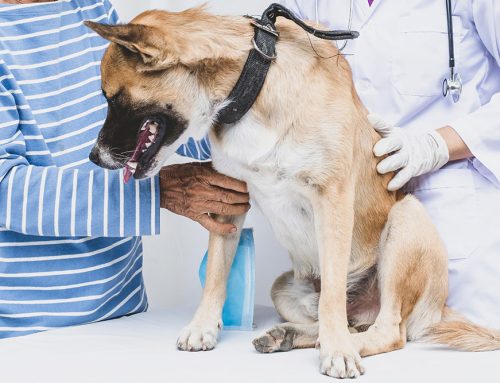As we gear up for warmer weather and longer days, we all are likely looking forward to spending more time outdoors. Unfortunately, spending time outside also means being exposed to all sorts of creepy crawlies, including pesky mosquitoes. While mosquito bites are usually only itchy and uncomfortable for us, they can pose a serious health risk to our pets in the form of heartworm disease.
Heartworm disease is caused by a roundworm parasite known as Dirofilaria immitis that is transmitted by mosquitoes. Once infected, pets can suffer permanent heart and lung damage and sometimes death. In the past, heartworm disease was considered a regional disease, found primarily in Southern states with warm, humid climates, but pets have now been diagnosed with heartworm disease in all 50 U.S. states and Canada. As conscientious pet owners, we must understand this disease, how it affects our pets, and how to prevent it.
At Adamson Veterinary Services, we are committed to helping pet owners and their furry friends stay healthy and happy, so we’ve put together this essential guide to heartworm disease and prevention.
What is heartworm disease?
The mature, adult heartworm is a parasite that lives in a pet’s heart and pulmonary arteries and can severely damage these vital organs. Coyotes are the primary heartworm carriers in the wild, and their proximity to neighborhoods where pet dogs live is one of the leading reasons for the disease’s rapid spread. Heartworm disease causes complications such as shortness of breath, fatigue, exercise intolerance, weakness, collapse, and sudden death. Pets who recover can still have lifelong damage.
How heartworm disease occurs in pets
The heartworm life cycle is long and complex and requires many steps and two animals. Here are the basic steps to infection:
- The bite — A mosquito bites an infected animal and ingests heartworm larvae (i.e., microfilariae).
- The babies — The microfilariae take 10 to 30 days to develop in the mosquito’s body.
- The next bite — The mosquito bites an uninfected animal and injects the microfilariae into their bloodstream.
- The circulation — The microfilariae circulate in the pet’s bloodstream and mature over several weeks.
- The maturation — Microfilariae travel through the pet’s bloodstream to their heart and pulmonary arteries, where they further mature into male and female adult heartworms.
- The reinfection — After about six months, the adults release new baby microfilariae into the bloodstream, which means more heartworms will develop inside the pet, and the now-infected pet will transmit the disease when they are bitten by a mosquito that then bites another animal.
Heartworm disease signs
Initial heartworm disease signs are subtle, may resemble other diseases, and differ in dogs and cats. For these reasons, diagnosis is rarely based on clinical signs alone.
Heartworm signs in dogs include:
- Soft, dry cough
- Exercise intolerance
- Lethargy
- Weight loss
- Rapid breathing
- Bulging chest
- Collapse
Heartworm signs in cats include:
- Wheezing
- Sudden onset cough
- Rapid breathing
- Vomiting
- Weight loss
- Sudden death
Heartworm diagnosis and treatment in pets
Dogs are considered perfect hosts for heartworms and upward of 30 adult worms can be living in their heart and lung tissue when they show signs and a diagnosis is made. The sheer number of worms makes diagnosing heartworms in dogs much easier, because dogs test strongly positive and the worms are clearly visible with diagnostic imaging. Your veterinarian can usually diagnose heartworm disease in minutes with a simple blood test, but they may still recommend follow-up X-rays or ultrasound imaging to determine the infection severity.
On the other hand, cats are resistant hosts for heartworms. Infected cats typically carry only one to three adult heartworms, so a diagnosis in cats can be extremely challenging, if not impossible—U.S. cats are seriously underdiagnosed, according to the American Heartworm Society. Also, cats may harbor only a few worms but, unfortunately, those worms can cause heartworm-associated respiratory distress (HARD) and other life-threatening complications. Therefore, regular veterinary check-ups and heartworm preventives that your veterinarian recommends are essential for your cat.
Heartworm disease also is challenging to treat. In dogs, treatment involves a series of injections administered over several weeks to kill the adult worms, but the dog must be confined and severely exercise restricted during treatment, because the dead and dying worms may obstruct the pulmonary arteries and affect blood and oxygen flow to the heart and lungs.
Unfortunately, no drug is approved for treating heartworm disease in cats—the same drug used in dogs can have serious side effects, such as pulmonary failure and death. In recent years, surgical removal of heartworms has emerged as a promising treatment for cats, but currently prevention is the only option.
Prevention: The best medicine for heartworm disease

The good news—heartworm disease is entirely preventable. Here are some tips on how to avoid this deadly disease:
- Use preventives — Safe and effective heartworm preventives are available as monthly chewable tablets or topical treatments. Injectables are also an option for some pets. Your veterinarian can recommend the best product and provide administration instructions, such as when and how to administer the drug. Consistency is essential and you must not miss a dose.
- Keep your pet indoors — Mosquitoes are most active during the warmer months, in the evenings, so try to keep your pet indoors during peak mosquito hours.
- Use mosquito repellent — If your pet must be outdoors during peak mosquito season, consider spraying mosquito repellent.
- Schedule regular checkups — Regular check-ups with your veterinarian can help catch heartworm disease early and prevent long-term damage to your pet’s health. Annual heartworm testing ensures your pet is heartworm disease-free.
At Adamson Veterinary Services, we are committed to helping pet owners keep their pets healthy and happy. Fortunately, heartworm disease is easily preventable, so let us develop a prevention protocol to protect your pet. Or, if you suspect your pet may have heartworm disease, don’t hesitate to contact us.







Leave A Comment